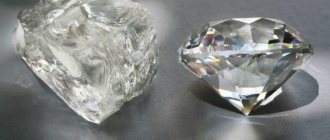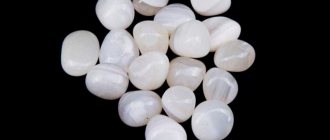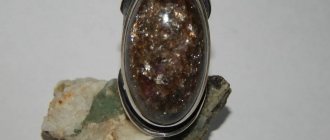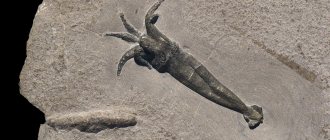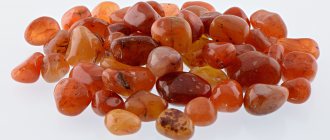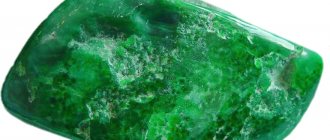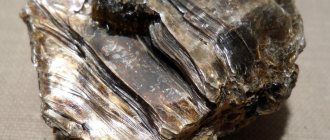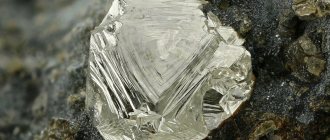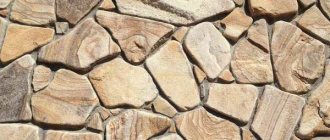What is a "desert rose"
From the point of view of a mineralogist, “desert rose” is one of the morphological varieties of gypsum.
Officially, the term is not in use; it is a colloquial or trade and advertising definition (like “sand rose” or “rose of sands”, also called Tunisia ).
Unusual natural formations are created by a frozen mixture of sand, gypsum and mineral salts.
“Desert Roses” differ in several ways, each with its own characteristics:
- Structure. There are single “buds” or their fusions (up to 5–8 pieces). Lens crystals resemble petals.
- Length of "petals" . Almost always 2–3 cm; in the Sahara there are specimens ten times larger.
- Color. Depends on the range of local sand. Most often classic yellow, sand, beige shades. There are reddish, white, black.
The “sand” origin plus gypsum and saturation with salts makes the petals hard, sharp, but fragile. This requires caution.
Desert Rose Mineral
Interesting places, Flora and fauna, Travel report to Tunisia, Douz; Tunisia, Tauzar; Tunisia, Matmata
From early childhood, I formed the idea of an oasis as a small island of vegetation near a small reservoir in the middle of the desert, where travelers could find temporary shelter, refresh themselves in a spring and relax in the shade of palm trees.
And only in Tunisia did I learn that in addition to desert oases, there are also mountain ones. Oases and mountains, an unimaginable combination! One of the most beautiful oases in Tunisia is the Shebika oasis, located at the foot of the Atlas Mountains, which was once an ancient Roman military camp.
Shebika itself is an abandoned village, abandoned by residents after prolonged rains and floods that almost washed the village off the mountainside. New Shebika, to which the residents of historical Shebika moved, is located nearby. In the Shebika oasis, water flows from a high cascade and forms a stream inside the gorge, surrounded by a whole palm grove. The spectacle is mesmerizing. Mostly date palms grow here. It’s been 4 years since I had the chance to see all this magnificence with my own eyes, some of the names have faded from my memory, but the delight I felt then still visits me.
It was a two-day trip to the Sahara, visiting the Colosseum, troglodyte dwellings and a salt lake, camel riding and jeep riding. I will not go into details and describe the entire route step by step. Moreover, the Internet is already full of similar reviews. I will dwell only on some of the most memorable details; it was from them that the overall impression of this unforgettable trip was created.
So.
How is stone formed?
Local Bedouin nomads associated the origin of the stone with a lightning strike in the sand or camel urine that got there.
Science has established the exact origin. The main raw material for the formation of the mineral is sand. That is, stones can only be found in deserts. But you need special sand, saturated with gypsum.
The process of formation of a “desert rose” is as follows:
- The precipitation falls into the sand.
- If the gypsum content is significant, the water carries it deeper.
- Due to the heat, the moisture evaporates, leaving crystalline gypsum in the sand.
- It sets, taking on shapes resembling a flower bud.
On the surface, the flower changes the arrangement of its petals and “blooms.” This is how wind and sulfates affect it. Sometimes the shapes are not floral, but whimsical.
Secrets of caring for a stone rose in the garden
Any garden flowers need to be carefully looked after, only then will they be able to develop properly. And although the survivor is not too whimsical, it is also demanding of certain factors and they should be taken into account.
- The peculiarity of succulents is that they perfectly accumulate water and are able to survive long periods of dry soil without any problems. Therefore, you do not need to water the plant every day, but once or three times a week during particularly hot months. Do not overdo it, otherwise the roots will begin to rot, which almost always leads to death. Keep an eye on the lower leaves, they are the ones who begin to respond to overflow first.
- Carry out the process itself under the plant, the outlet should not be wet.
- Loosening the soil around the crop has the most beneficial effect on it. This helps get rid of weeds, the roots begin to breathe better, and ventilation increases, which prevents moisture accumulation. But keep in mind that the rhizome is almost on the surface, so carry out the process extremely carefully.
- Remove dead plants and weeds in a timely manner.
- What attracts gardeners to the stone rose? It does not need to be fertilized, unlike many other crops. Fertilizing worsens the saturation of the leaves and makes the plant more vulnerable to frost. Only three-year-old flowers need help. Buy a special preparation for succulents and cacti, use only half the volume of the indicated dose.
Light-loving stone roses must be prepared for cold weather. Delicate and delicate flowers will simply die in the first winter. The process itself is not too complicated.
- Prepare shelter. Plastic bottles with a volume of 5 liters are perfect for protection. Cut off the top of them.
- Punch holes with an awl 1 cm from the cut. There shouldn’t be too many of them; five to seven pieces is enough.
- If such a bottle is too large, select another container that is suitable in width. If one container is not enough, then take several pieces.
- Turn the vessel upside down and place it above the flower bed. To prevent it from being blown away by the wind, secure the bottle with metal rivets or pins. That's what the holes are for.
- Carefully cover the one-year-old juveniles with spruce branches, and they will survive their first winter in an open area just fine.
Where and how is it found
Stone deposits are deserts of almost all continents: both Americas (USA, Mexico, Argentina), Australia, northern Africa (Egypt, Tunisia, Algeria).
Argentina supplies black stones, Tunisia supplies white stones from the Sahara.
Such formations are hidden under a layer of sand, at a depth of about a meter. Appear on the surface due to sandstorms. The local population does not count on the mercy of nature: search expeditions are constantly organized, because the sandy “desert rose” is popular among tourists.
In the rock garden
A rockery is a decorative composition in which the main role is given to stones, and plants serve only as bright accents designed to make the picture more lively and natural. If you choose a sunny place and manage to properly organize the drainage, then you will not find a better place to plant juveniles. A plant surrounded by stones will exist in almost the same conditions in which it lives in its natural environment, and will not suffer from weeds.
- How to make a beautiful rock garden with your own hands
Have you decided to create a spectacular rock garden on your site? We'll tell you how to set up a “stone flowerbed” and what plants to choose for it.
Price
“Desert Rose” is not a precious mineral; the cost of jewelry or collectibles is affordable to everyone.
The jewelry frame is often silver (925°). The price of the pendant is 970–1200 rubles, the ring is twice as expensive.
Jewelry with desert rose stone
Collectible samples are expensive, but there are affordable specimens: a single “flower” (Mexico, 30–40 mm, 30 g) – 250–300 rubles, splices – from 1.5 thousand.
Methods for propagating stone roses
Most people are afraid to purchase several specimens at once, but then they realize the value and beauty of these plants and think about buying a few more succulents. But the tenacious creature reproduces easily, so you don’t have to resort to store services and try to get new stone roses yourself.
There are several methods of propagation: seeds, cuttings or leaves.
Vegetative (cuttings or leaves)
- Choose the healthiest and most beautiful succulent in your flower bed. Separate from it the leaf located closer to the trunk. He shouldn't be too young.
- Or cut off the top of the bush, tearing off the lowest leaves.
- Dry the workpieces for several hours.
- At this time, mix vermiculite and sand in equal proportions. Moisturize it.
- Stick the cutting or leaf into the prepared soil and place it in a well-ventilated and sunny place.
- So the plant should stand for a month. Moisten the soil periodically.
- During these 30 days, in good conditions, an outlet should appear. It will take 2 to 3 months for its final formation. The maternal part will dry out at this time.
- Transplant the new organism into a separate pot with cactus soil.
Seeds
- For this method you will need peat and sand. Place their mixture in a suitable box.
- Stick the seeds shallowly into the ground (4-5 mm). Spray the soil with a spray bottle. Cover everything with film.
- The container is left in a warm (20-25 degrees) and lighted room.
- Moisten the soil as needed.
- After two weeks, the succulents will appear above the ground, and the young ones are transplanted when 2-3 well-developed leaves are formed.
Magic properties
“Desert Rose” is considered a “highly moral” mineral:
- It can save the owner from temper and arrogance. The stone “insidiously” creates a problematic situation for the owner. A person finds himself in a dangerous or ridiculous situation, which prompts him to reconsider his self-esteem and value system. The mineral reminds: wealth and position in society are fragile.
- The “desert rose” will support good but insecure people and relieve them of suspiciousness.
- This is a symbol of eternal strong love, therefore it is considered a gift with special meaning for Valentine's Day. Africans have a belief that the stone attracts a soul mate. It is given to young ladies who dream of marriage. It’s even better for the girl to find him herself. If it comes to the wedding, the bride’s parents give the newlyweds a stone: the family hearth will be strong and life will be happy.
Its reputation as a stone of fidelity has made the "desert rose" a desirable Valentine's Day gift among Europeans.
- The magical properties of yellow-colored specimens are used as a channel of communication with the souls of deceased relatives.
- In African countries, the stone is considered a home amulet against witches and sorcerers.
Astrologers have found that the “desert rose” is suitable for Capricorns, Leos, Sagittarius, and Aries. Each of them is impulsive, often does not control words and actions. The pebble will keep you from quarrels or conflicts. At the same time, it will help you look at the world philosophically.
LiveInternetLiveInternet
Wednesday, May 29, 2022 19:42 + to quote book
[/td]
“Desert Rose” is an unusual mineral that can be found in dunes. Outwardly, it really resembles a blossoming flower bud. Where does such a miracle of nature come from, we will find out from the article. *Why is the stone called “Desert Rose”
The stone is called “Desert Rose” for several reasons:
- the mineral can only be found in deserts - externally the stone is very reminiscent of a rose Of course, it is far from the original flower.
The color is significantly different. The mineral has several shades (it all depends on the color of the sand in the desert). As a rule, these are beige or yellowish tones. In rare cases, you can find white (deserts of Argentina) and black minerals (Tunisia). The size of the stone may also vary. The crystals that make it up are mostly small. Due to this, the mineral reaches only 2-3 cm in diameter. But in history there are cases when “Desert Roses” measuring more than 25 cm were found. Such unusual giant stones were found in the Sahara Desert. The petals of the “Desert Rose” are quite fragile, but at the same time sharp, like a knife blade. This is due to the large amount of salt that is in the composition. You need to be extremely careful with them so as not to get hurt. *Features of formation and deposit
Many are interested in how the “Desert Rose” is formed. There are many myths and legends associated with this. But scientists have long uncovered the mystery of the appearance of an unusual mineral, explaining everything from a scientific point of view.
In order for a stone to form, certain favorable conditions must be created in the desert. The main thing in this process is moisture. After precipitation, precipitation is quickly absorbed into the soil, which contains a high content of sand and gypsum. Under the scorching sun, the liquid evaporates, gypsum crystals are formed, which have an unusual, twisted shape. In addition, sand settles on them, which gives the mineral a velvety feel. The “Desert Rose” is located under a layer of sand and appears on the surface only after sandstorms. When interacting with air and wind, it may unravel slightly. This interesting and surprising process is possible thanks to sulfates, which are contained in large quantities in the mineral. The Desert Rose stone is found in Egypt, Tunisia, the deserts of Argentina, and Algeria. Since the minerals are located under the sand (1-2 m), locals even organize special expeditions to extract them. The stone is in great demand among tourists, so a real hunt is open for it. *Magical properties of the mineral
Local residents perceive the “Desert Rose” stone quite differently from tourists. For them, this is not just a beautiful souvenir, but also a mineral that is filled with special power.
According to many beliefs, the magical properties of the stone are to deliver a person from pride. Locals believe that if the mineral is given to a proud person, a life situation will be created in which he will understand that he cannot put himself “above everyone else.” In addition, in African countries there are legends that the stone was created by a guy in love who walked through the desert in search of medicine for his soulmate. His tears wet the sand and the Desert Rose appeared. That is why the mineral symbolizes love and fidelity. The parents of a girl who is getting married present a stone to their daughter so that her marriage will be strong and prosperous.
It is also believed that if a girl cannot get married, it is enough to take out a stone and ask him for a groom, who will definitely appear soon. “Desert Rose” also has medicinal properties. Many people believe that in case of fractures, the stone should be located next to the patient’s bed. The bones seem to heal faster. *Interesting facts
“Desert Rose” is an unusual stone, because it was made by nature itself. That is why there are many legends around the mineral.
Some interesting facts to know:
-Locals do not always call the stone “Desert Rose”. The second popular name is “Rose of the Sands”. -The mineral cannot be exported. If it is detected at customs, a fine will be issued. But at the same time there is a so-called “black market”. The stone can be seen in Europe and America. It is in huge demand before Valentine's Day. -The mineral is most suitable for the following zodiac signs: Sagittarius, Capricorn, Aries and Leo. -In some countries it is believed that the mineral protects the house from witches and sorcerers. And yellow-colored stones help communicate with the souls of the dead. - “Desert Rose” is in great demand. That's why some jewelers frame the stone in silver or gold. Such decorations look quite interesting. “Desert Rose” is a mineral that leaves no one indifferent. It is not only beautiful, but also has magical properties (according to local beliefs). Not every desert can contain such a treasure. For its appearance, favorable conditions are needed: moisture, the presence of gypsum in the sand. https://attuale.ru/roza-pustyni-magicheskie-svojst...adochnyj-i-neobychnyj-mineral/
| Categories: | INTERESTING AND EDUCATORY |
Cited 1 time Liked by 1 user
Like share
0
Like
- 1
I liked the post - Quoted
- 0
Saved
- Add to quote book
- 0
Save to links
Liked1
0
Therapeutic effect
The healing properties of the “gypsum” stone coincide with the official medical ones:
- Help bones heal quickly and correctly after a fracture.
- Cure spinal tuberculosis. A plaster bed is made for the patient, which should speed up recovery.
- Powdered gypsum helps with excessive sweating (hyperhidrosis).
Since the time of Cleopatra, cosmetologists have been using an aqueous mixture of gypsum powder with olive oil as a tonic mask for the face.
Tunisia stone
Features of growing stone roses at home
Juveniles are also excellent for home growing. It should be remembered that in indoor conditions the flower takes root very well, but after that it can no longer be transplanted to an open area, as it simply will not take root.
In principle, the rules of care do not really change:
- Choose exclusively southern sides so that the survivor can receive enough sunlight every day. Even on western and eastern windows there will be a shortage, and on northern windows the succulent will completely wither.
- If you want his plant, but you don’t have enough sun at home, then build a source of additional lighting.
- Juveniles need to be watered very rarely. Just two or three times in the winter months and once a week in the summer is enough.
- Don't think there isn't enough moisture. It is more dangerous to overwater a flower than to underwater it, since it tolerates drought very well and rarely dies from lack of water.
- Use a mixture of sand, peat or leaf soil as soil. Loosen it carefully from time to time.
Since stone roses are practically not susceptible to pests and diseases, they will appeal to lovers of indoor plants. Weeds and cockchafers do not threaten them, the main thing is not to overwater them so that the root system does not rot.
What plants can a succulent be placed next to?
The succulent is used in the garden to decorate alpine slides and flower beds. Most often, the plant is used for group plantings together with other ornamental crops. But a flowerbed that combines several species with different shapes and colors of leaves looks no less impressive.
In rutarium
Rutaria (from the English root) are garden compositions made from old tree trunks, stumps and snags that harmoniously fit into the landscape of the territory. The ability to occupy as much free space as possible with a variety of decorative elements, in this case exclusively natural, will help solve the problem of ensuring the safety of the root system of the young. At the same time, it is not necessary to plant the young directly into the ground. A composition in which the role of a pot for the young would be played by a stump or an unusually shaped piece of driftwood would look no less impressive and organic.
